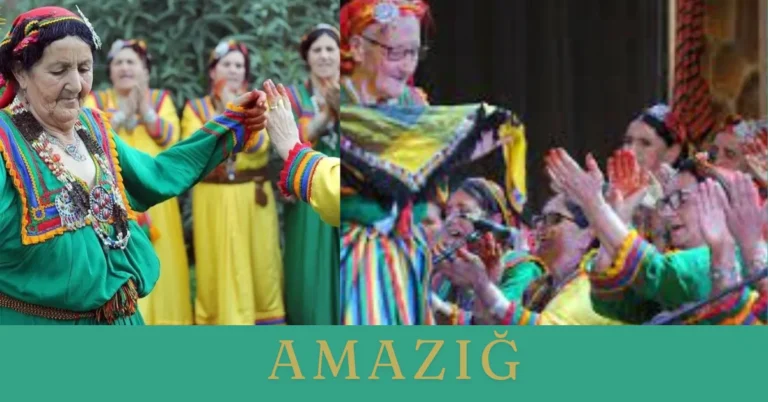Introduction to Amaziğ Culture
Welcome to a journey through the vibrant tapestry of Amaziğ culture – a timeless legacy that weaves together history, beliefs, and customs deeply rooted in tradition. Join us as we explore the rich heritage of the Amaziğ people and delve into their fascinating world filled with intriguing stories and captivating contributions to society. Let’s embark on an adventure to discover the beauty and resilience of the Amaziğ culture!
History of the Amaziğ People
The history of the Amaziğ people is a tapestry woven with resilience and cultural richness. Originating from ancient Berber tribes, the Amaziğ have thrived in North Africa for centuries, shaping their identity through diverse influences.
Through periods of conquests and colonization, the Amaziğ have fiercely preserved their traditions and language, embodying a spirit of independence. From the Atlas Mountains to the Sahara desert, they have cultivated a deep connection to their land and heritage.
Despite facing challenges throughout history, including marginalization and assimilation attempts, the Amaziğ people have persevered with unwavering pride in their roots. Today, they stand as guardians of a legacy that reverberates through time – a testament to their enduring strength and cultural vibrancy.
Traditional Beliefs and Customs
Embarking on a journey into the heart of Amaziğ culture unveils a tapestry woven with rich traditional beliefs and customs that have stood the test of time. From sacred rituals to intricate ceremonies, every aspect is steeped in significance.
The Amaziğ people hold deep reverence for nature, viewing it as a source of spiritual connection and guidance. Their customs often reflect this profound respect through ceremonies honoring the changing seasons and agricultural cycles.
One such custom is the annual Imilchil Marriage Festival, where tribes gather to celebrate love and unity. This unique tradition showcases the importance of community bonds and intertribal relationships among the Amaziğ people.
Moreover, traditional music and dance play a vital role in preserving cultural heritage. The rhythmic beats of drums echo stories of resilience and triumph passed down through generations.
Exploring these age-old beliefs offers a glimpse into the soulful essence of Amaziğ culture, where every ritual carries layers of meaning waiting to be uncovered.
Influence on Modern Society
The influence of Amaziğ culture on modern society can be seen in various aspects of our daily lives. From language and art to music and fashion, the rich traditions of the Amaziğ people continue to shape contemporary trends and practices.
Amaziğ languages have influenced numerous modern vocabularies, with words like “azul” meaning “hello” finding their way into popular culture. Additionally, traditional Berber patterns and designs are often incorporated into modern fashion collections, adding a touch of authenticity and uniqueness.
In the realm of music, artists draw inspiration from traditional Amaziğ melodies and instruments, infusing them into contemporary compositions. This fusion creates a harmonious blend of old and new that resonates with audiences worldwide.
The enduring legacy of the Amaziğ people serves as a testament to their resilience and creativity. Their impact on modern society is profound and continues to evolve with each passing generation.
Famous Amaziğ Figures and Contributions
The Amaziğ culture boasts a rich history filled with remarkable figures who have left an indelible mark on society. One prominent figure is Fatima al-Fihri, the founder of the world’s oldest university, located in Morocco. Her contributions to education continue to inspire generations.
Another renowned Amaziğ figure is Ibn Battuta, a medieval explorer whose travels spanned from Africa to Asia and Europe. His detailed accounts of diverse cultures provide valuable insights into historical trade routes and civilizations.
Ahmed Baba, a revered scholar from Timbuktu in Mali, made significant contributions to Islamic studies and literature during the 16th century. His works remain influential in academic circles today.
These iconic Amaziğ personalities showcase the depth of talent and intellect within the culture, underscoring their enduring impact on global heritage.
Preservation Efforts and Challenges:
Preserving the rich Amaziğ culture is a labor of love for many passionate individuals and organizations. Efforts to document traditional practices, languages, and art forms are crucial in ensuring that this unique heritage is safeguarded for future generations.
One of the challenges faced in preserving Amaziğs culture lies in the rapid modernization and globalization that can sometimes overshadow or dilute these age-old traditions. Finding a balance between embracing progress while honoring ancestral customs is a delicate dance that requires careful navigation.
Additionally, as younger generations gravitate towards more contemporary lifestyles, there is a risk of certain aspects of the Amaziğs culture fading into obscurity. This highlights the importance of education and awareness initiatives to instill pride and appreciation for their roots.
Despite these obstacles, dedicated individuals continue to champion preservation efforts through cultural events, educational programs, and community engagement. By uniting forces and fostering a sense of belonging among Amaziğs communities worldwide, the legacy of this timeless culture can endure for years to come.
Conclusion: Celebrating the Richness of Amaziğ Culture
Celebrating the Richness of Amaziğs Culture
In a world that is constantly evolving, it is essential to preserve the unique cultural heritage of communities like the Amaziğs people. Their history, traditions, and beliefs are not just stories of the past but living treasures that continue to shape identities and inspire generations.
By delving into the rich tapestry of Amaziğs culture, we uncover a timeless legacy that deserves recognition and celebration. From their deep-rooted connection to nature to their vibrant art forms and music, every aspect reflects a profound sense of identity and belonging.
As we navigate through modern society with its fast-paced changes, let us pause for a moment to cherish the beauty and wisdom encapsulated in Amaziğs culture. Let us honor their resilience in preserving traditions amidst challenges and embrace the richness they bring to our global tapestry.
In essence, celebrating Amaziğs culture is not just about looking back at history but also about embracing diversity, fostering inclusivity, and appreciating the multitude of voices that enrich our shared human experience. Let us stand together in admiration of this enduring culture’s contributions towards creating a more vibrant and interconnected world for all.
FAQs
Q : Who are the Amaziğ people?
Ans: The Amaziğ people are an ancient ethnic group indigenous to North Africa, known for their deep cultural heritage and historical significance.
Q : What is the history of the Amaziğ people?
Ans: The Amaziğ people have roots dating back over 10,000 years, making them one of the oldest continuous cultures in North Africa, with a rich history shaped by their connection to the land.
Q : How has Islam influenced the Amaziğ culture?
Ans: Islam has had a significant influence on Amaziğ culture, blending with their traditional beliefs and practices to create a unique cultural identity in North Africa.
Q : What are some key aspects of Amaziğ culture?
Ans: Amaziğ culture is characterized by its language, traditions, music, art, and strong community bonds, reflecting their historical resilience and adaptation over millennia.
Q : Why is the Amaziğ culture considered timeless?
Ans: The Amaziğ culture’s longevity and resilience through centuries of change demonstrate its timeless relevance and enduring impact on North African society.

